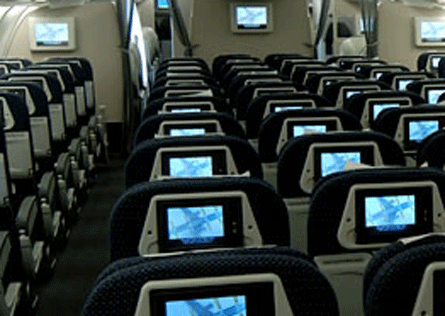Major players in the in-flight entertainment (IFE) and communications industry are witnessing a substantial rise in airline expenditure for premium onboard services, as the entire cabin environment becomes a "driving force of airline business success", the former head of IATA says.
After years of sluggish innovation, carriers "have recently begun to pour millions of dollars into improving their cabin product, elevating first and business class to new heights, while reducing the back-end of the airplane to a flying merchandise mart", said Pierre Jeanniot in a keynote address at the World Airline Entertainment Association (WAEA) conference and exhibition in Toronto.
Though difficult to quantify an exact return on investment, "investing in premium service is simply mandatory for any carrier committed to remain a credible player in that market segment", says Jeanniot, who now holds the chairmanship at Thales Canada.
Hardware manufacturers, satellite service providers and software makers exhibiting at WAEA confirm the latest upturn. They tell ATI, flightglobal.com's sister news service that airlines are showing a renewed interest in advanced interactive IFE systems that will allow new technologies to be introduced on a plug-and-play basis, and a genuine clamor for connectivity services.
Panasonic, for example, has been working with Apple Computer on a cable and jack that allows passengers to play music and videos from their iPods over installed IFE systems. Several airlines signed up last year. A Panasonic spokeswoman says the firm expects to soon announce its latest developments on this front.

Lighting and electronics specialist Astronics says in-seat power, which was once largely reserved for the front of the cabin, is now being offered "nose-to-tail". This development has largely occurred in the last two years, says executive VP Mark Peabody. US start-up Virgin America "out of the gate…came out equipped", notes Astronics senior director, cabin electronics Michael Hettich.
Satellite network operators are also benefiting from the drive for connectivity. Inmarsat has long provided satcom voice and data services for the aeronautical sector, but is now offering SwiftBroadband service. Although the company’s land and maritime services comprise 93% of its business, aeronautical is the "fastest growing of all the businesses" and currently accounts for 7%, says head of marketing, aeronautical business Lars Ringertz.
The combination of personal electronic devices working in concert with an airline-provided broadband delivery system "is a likely model of IFE in the future", says Jeanniot.
Additionally, the more sophisticated IFE systems are accommodating new forms of service and advertising, helping airlines to "monetize" the cabin. These measures help ensure that recently installed IFE systems will not be made redundant in the near future by passengers bringing their portable data and entertainment devices onboard, says Jeanniot.
"IFE has become the most expensive item on an aircraft, just after the engines. So, it had better do a helluva job of differentiating the high-end product and generating revenues in the low-end," he says.
The Thales Canada chairman adds: "There are great opportunities ahead to devise new ways of meeting the evolving needs of the flying public, to contribute to the bottom line of the airlines, and to the bottom line of your company."
Source: FlightGlobal.com



















